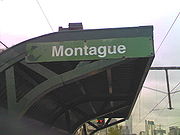
Metropolitan Transit Authority (Victoria)
Encyclopedia

Government of Victoria
The Government of Victoria, under the Constitution of Australia, ceded certain legislative and judicial powers to the Commonwealth, but retained complete independence in all other areas...
owned corporate body that operated suburban passenger trains,trams and buses in Victoria
Victoria (Australia)
Victoria is the second most populous state in Australia. Geographically the smallest mainland state, Victoria is bordered by New South Wales, South Australia, and Tasmania on Boundary Islet to the north, west and south respectively....
, Australia
Australia
Australia , officially the Commonwealth of Australia, is a country in the Southern Hemisphere comprising the mainland of the Australian continent, the island of Tasmania, and numerous smaller islands in the Indian and Pacific Oceans. It is the world's sixth-largest country by total area...
. It was set up under Section 15 of the Transport Act 1983
Transport Act 1983
The Transport Act 1983 was the main statute establishing government transport organisations and regulating land transport activities in the State of Victoria, Australia for 27 years from mid 1983 to mid 2010...
and commenced operation on 1 July 1983. It was a statutory body set up to manage the trams
Trams in Melbourne
The Melbourne tramway network is a major form of public transport in Melbourne, the capital city of the state of Victoria, Australia. , the network consisted of of track, 487 trams, 28 routes, and 1,773 tram stops. It was therefore the largest urban tramway network in the world, ahead of the...
formerly operated by the Melbourne and Metropolitan Tramways Board, the metropolitan train
Railways in Melbourne
The Melbourne rail network is operated by Metro Trains Melbourne under franchise from the Government of Victoria. The network is based on a commuter rail model centred on the Melbourne Central Business District and Flinders Street Station, rather than a rapid transit model, with a focus on...
operations of the former VicRail, and the operations of the former Melbourne Underground Rail Loop Authority (MURLA).
The authority employed more than 12,000 people across five divisions in 1984-85. The aim of the authority was to integrate the provision of public transport in Melbourne. A green and gold livery was adopted for vehicles, with a yellow trefoil
Trefoil
Trefoil is a graphic form composed of the outline of three overlapping rings used in architecture and Christian symbolism...
logo and "Metropolitan Transit" tagline (Later changed to 'The Met').
Divisions

The 'Met Bus' and 'Met Tram' divisions took over the services operated by the former MMTB.
By 11 April 1988, integration of the transport systems had been achieved and the separate divisions brought together. The management of the Authority was restructured into three vertically integrated
Vertical integration
In microeconomics and management, the term vertical integration describes a style of management control. Vertically integrated companies in a supply chain are united through a common owner. Usually each member of the supply chain produces a different product or service, and the products combine to...
directorates concerning operations, project development, and resources. The MTA was merged with the State Transport Authority
State Transport Authority (Victoria)
The State Transport Authority was a State Government of Victoria owned corporate body which operated country passenger and freight trains in Victoria, Australia. It was established under the Transport Act 1983, succeeding the Victorian Railways...
on 1 July 1989 to form the Public Transport Corporation
Public Transport Corporation
The Public Transport Corporation was a State Government of Victoria owned corporate body formed under the Transport Act 1983 which operated passenger and freight trains, trams and bus services in Victoria, Australia....
. In 1997, the government announced that The Met would be privatised. Sections of railway to the east and north of Melbourne fell under Hillside Trains, while the west and south fell under Bayside Trains. The tram network was split between Swanston and Yarra Trams. Bus services were privatised between 2 separate bus operators, National Bus Company
National Bus Company
The National Bus Company, or NBC, was the Australian brand for National Express Group's mass transit bus services in Melbourne and Brisbane. Its sister companies were Westbus, Hillsbus, and Glenorie in Sydney, Southern Coast Transit in Perth.-Routes:...
and Melbourne Bus Link
Melbourne Bus Link
Melbourne Bus Link is a Melbourne bus company, owned by a joint partnership between Dyson's and Reservoir Bus Companies to run government operated routes covering the western and south east regions of Melbourne.-Routes:...
. The Met logo can still be seen in various places, including the Kew Tram Depot, Camberwell Station & the Deakin University Bus Terminal.

